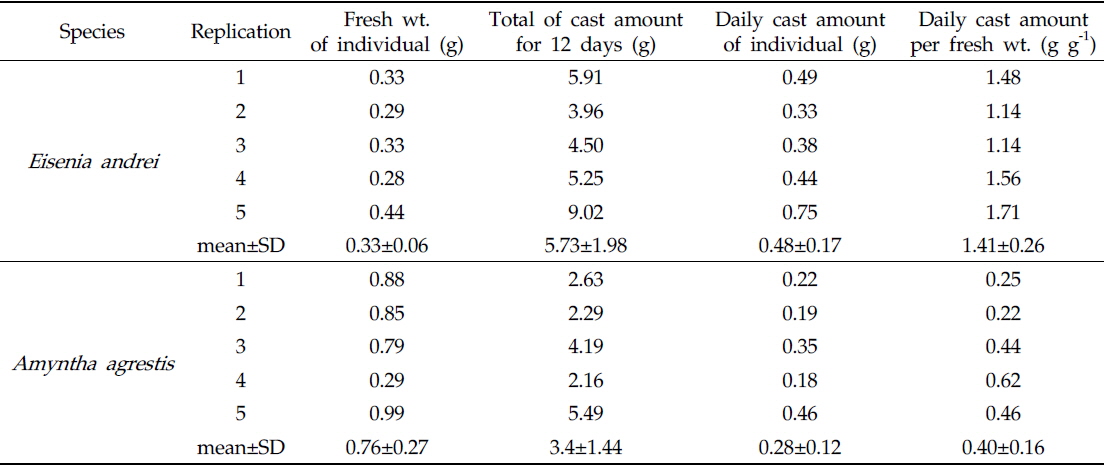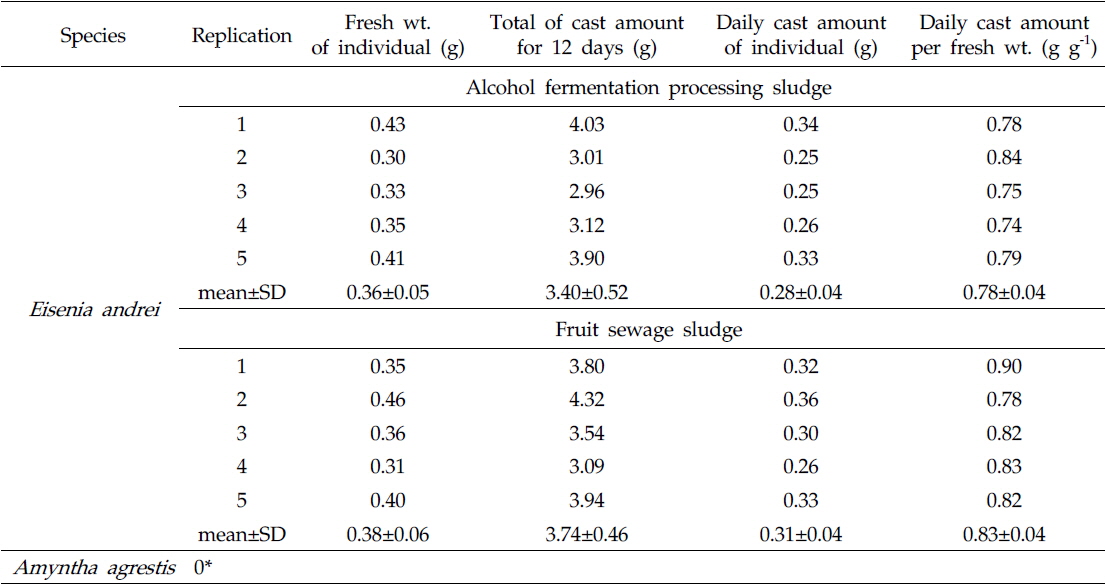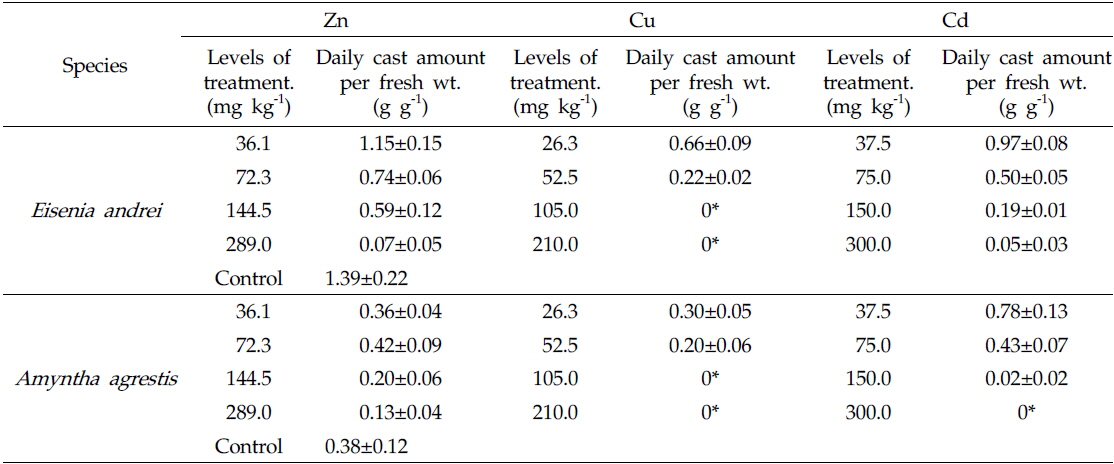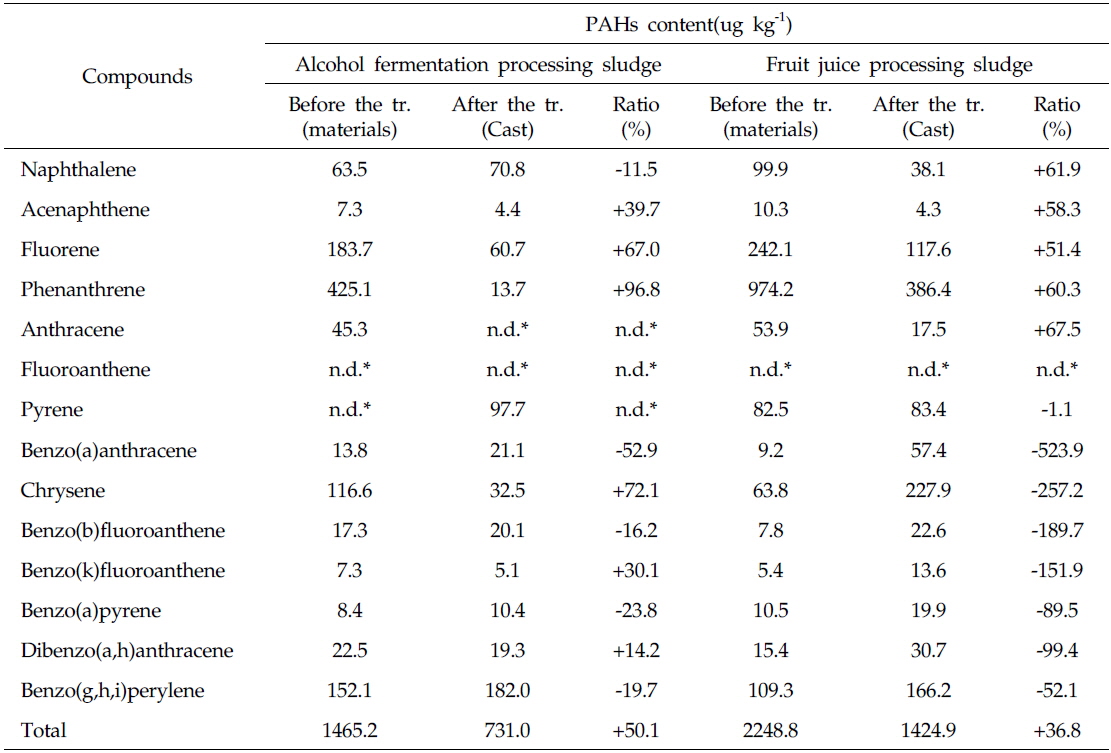



Earthworms are essential detritus feeders that play a vital role in the process of decomposition of organic matter and soil metabolism. The complex process of partial breakdown of organic matter and mixing with mucous and gut microbial flora in the form of earthworm cast results in the reduction of the toxicity. This study focused on the change of cast amount and pollutant contents before and after the eating of the organic waste and upland soil with the two species of earthworm.
The two species of earthworms were compared to the cast production. In the upland soil material, the daily amount of worm’s cast was 1.42 g in
In conclusion, although the
농업생태계 내에서 유해한 오염물질의 유입증가는 국민건강과 관련하여 사회적 문제로 대두되고 있으며 농산물 안전성에 관련된 여러 국제기구에서도 각종 오염물질에 대한 규제기준을 강화하고 있는 추세이다(Holmgren
유기성폐기물의 재활용에 대한 연구는 1970년대 이전까지 주로 인축분뇨를 대상으로 작물의 영양원과 토양개량제로서의 가치를 평가하고 적정 사용기준을 설정하였고 그 후 1980년대의 화학비료 남용에 따른 토양 비옥도 저하문제가 대두되고 토양 유기물의 중요성이 부각되어 유기성폐기물의 농업적 활용에 다한 관심이 커지면서 유기성폐기물 시용에 따른 토양환경 변화를 평가하기 위한 연구가 활발하게 수행되었다. 1990년대 이후부터는 폐기물의 처리가 사회문제화 되어 폐기물 처리개념에서 퇴비화가 정책적으로 장려되었다(Lerch
따라서 밭토양과 유기성폐기물에서 지렁이의 분변토 발생량 및 오염물질(중금속, PAHs)의 변화 특성을 밝히고자 하였다.
실험에 사용된 지렁이는 2종류이다(Fig. 1). 낚시지렁이과(Lumbricidae)에 속하는 붉은줄지렁이(
밭토양은 야산에 있는 토양시료를 채취하여 2 mm 체로 선별한 후 밭토양을 분석하였다(Table 1). pH, 유기물, 양이온, 중금속의 함량이 적었고, 토성은 사양토였다. pH만 조절하여 사용하면 지렁이가 서식하고 섭식하는데 문제가 없는 것으로 판단했다.
[Table 1.] Chemical properties of the upland soil

Chemical properties of the upland soil
유기성폐기물은 주정슬러지와 과즙슬러지를 각각 국내 공장에서 채취하여 분석하였다(Table 2). 주정슬러지와 과즙슬러지는 지렁이가 서식하고 섭식하기에 pH, 유기물, 질소, 인산, 가리 함량이 적정범위였으나, 중금속은 아연과 구리의 함량이 많은 것이 특징이었다.
[Table 2.] Chemical properties of the organic wastes

Chemical properties of the organic wastes
분변토의 발생량 및 중금속이 분변토 발생에 미치는 영향을 평가하기 위하여 밭토양 90%에 피트모스 10%를 혼합하여 섞고, 증류수를 부어 토양수분 함량이 50%가 되게 만들었으며, pH는 탄산칼슘(CaCO3)을 첨가하여 6.0±0.5 범위가 되도록 조절하여 만들었다. 또한 중금속 함량에 따라 분변토 발생량을 조사하기 위하여 아연은 zinc nitrate(Zn(NO3)26H2O), 구리는 copper nitrate(Cu(NO3)23H2O), 카드뮴은 cadmium nitrate(Cd(NO3)24H2O)을 시약으로 구입하여 밭토양에 지렁이 치사에 영향 없는 무영향농도(Spurgeon, 1994)와 무영향농도의 2, 4, 8배를 감량하여 밭토양과 혼합한 후 지렁이 3마리를 각각 처리하였고, 자세한 절차 및 실험방법은 Na(2000) 문헌을 따라 했다.
중금속은 마이크로웨이브 전처리 장비(Mars-X, CEM)를 이용하여 시료 0.5 g을 마이크로웨이브 vessel에 취하여 분해액인 왕수(HNO3:HCl=1:3) 12 ml를 가한 다음 미국 EPA-method 3051a법에 근거한 분해조건으로 분해하였고, 분해된 시료는 초순수를 가하여 50 ml로 채워 분석용 시료로 사용하였다. 수용성 화학성분 및 중금속 분석은 폐기물공정시험법인 용출시험법을 응용하여 증류수로 침출한 후 여과하여 분석용 시료로 사용하였다.
PAHs는 US EPA의 우선감시물질 목록에 포함된 14가지 PAHs (Naphthalene, Acenaphthene, Fluorine, Phenanthrene, Anthracene, Fluoranthene, Pyrene, Benzo(a)anthracene, Chrysene, Benzo(b)fluoroanthene, Benzo(k)fluoroanthene, Benzo(a)pyrene, Dibenzo(a,h)anthracene, Bbenzo(g,h,i) perylene)를 분석하였다. 시료 5 g을 무수황산나트륨 20~50 g과 혼합하여 시료 내 수분이 제거된 상태에서 원통여과지에 넣고 Soxhlet에 장착하여 열판에서 16시간 동안 추출하였다. 이 때 사용된 추출용매는 dichloromethane 200 mL이었다(US EPA, 1994).
밭토양에서 붉은줄지렁이 한 마리가 하루에 0.33~0.75 g의 분변토를 배설했고, 밭지렁이는 0.18~0.46 g의 분변토를 만들어 냈다(Table 3). 붉은줄지렁이 생체무게 1 g에 평균 1.41 g의 분변토를 만든 반면에 밭지렁이는 1 g에 평균 0.40 g의 분변토를 만드는 것으로 분석되었다. 붉은줄지렁이는 자기 체중보다 1.40배 많은 분변토를 만들었고, 밭지렁이는 0.4배로 적게 분변토를 만들었다. Choi(1992)는 붉은지렁이(
[Table 3.] Cast amount of earthworm species for 12 days in the upland soil

Cast amount of earthworm species for 12 days in the upland soil
유기성폐기물에서 붉은줄지렁이 한 마리가 하루에 0.25~0.36 g의 분변토를 배설했고, 밭지렁이는 모두 죽어서 분변토를 얻지 못했다(Table 4). 붉은줄지렁이 생체무게 1 g에 주정슬러지 분변토 0.78 g, 과즙슬러지 분변토 0.83 g를 각각 만드는 것으로 분석되었다. 이는 붉은줄지렁이 체중보다 적게 분변토를 만들었다. 이것은 밭토양에서 자기 체중보다 많이 만든 것과는 대조적이다. 붉은줄지렁이는 분변토를 적게 만들고 밭지렁이는 모두 죽은 이유는 유기성폐기물의 오염물질들이 영향을 미친 것으로 생각된다.
[Table 4.] Cast amount of earthworm species for 12 days in the organic wastes

Cast amount of earthworm species for 12 days in the organic wastes
밭토양에 중금속을 농도별로 처리한 후 2종류의 지렁이 분변토 발생량을 조사했다(Table 5). 아연 처리구의 분변토 발생량은 붉은줄지렁이 0.07~1.15 g, 밭지렁이 0.13~0.42 g이었고 대조구와 비교하면 중금속 농도가 높을수록 대체로 분변토 발생량이 적었다. 구리는 붉은줄지렁이 0.22~0.66 g, 밭지렁이 0.20~0.30 g이었고 무영향농도의 2배(105 mg kg−1)와 4배(210 mg kg−1)을 감량한 처리구에서는 지렁이가 모두 죽어서 분변토를 조사하지 못했다. 카드뮴은 붉은줄지렁이 0.05~0.97 g으로 대조구보다 농도가 높을수록 분변토 발생량이 적었고, 밭지렁이 0.02~0.78 g으로 대조구(0.38 g)보다 무영향농도 2배 감량(150 mg kg−1)에서 0.02 g으로 현저히 적었으나, 4배 감량와 8배 감량 처리구에서는 오히려 많은 분변토가 발생했고 무영향농도에서는 지렁이가 모두 죽었다. Spurgeon
[Table 5.] Effect of earthworm’s cast amount with levels of heavy metals in the upland soil

Effect of earthworm’s cast amount with levels of heavy metals in the upland soil
>
지렁이 섭식 전후의 중금속과 PAHs (polycyclic aromatic hydrocarbons) 함량 변화
유기성폐기물(주정슬러지, 과즙슬러지)에 대한 붉은줄지렁이의 섭식 전후의 중금속(Zn, Cu, Cd) 함량의 변화를 조사했다(Table 6). Table 4에서 조사된 것처럼 밭지렁이는 유기성폐기물에서 모두 죽기 때문에 제외했다. 붉은줄지렁이 분변토의 중금속 함량은 지렁이가 먹은 슬러지보다 0.7~53.3%까지 더 증가했다. 주정슬러지에서는 아연 23.4%, 구리 53.3%, 카드뮴 21.3%가 증가했고, 과즙슬러지는 아연 24%, 구리 0.7%, 카드뮴 29.9%가 증가했다.

Change of heavy metal content before and after the eating of organic wastes with earthworm, Eisenia andrei
PAHs의 함량 변화는 Table 7과 같다. 주정슬러지에서 14종류 유기화합물의 총량은 1,465 ㎍ kg−1이었으나 붉은줄지렁이가 섭식하고 배설한 분변토에서는 731 ㎍ kg−1로서 50.1%가 감소했다. 과즙슬러지도 2,249 ㎍ kg−1에서 1,423 ㎍ kg−1으로 36.6%가 감소했다. 두 종류의 슬러지에서 지렁이의 섭식후에 분해되어 함량이 적어진 유기화합물은 Acenaphthene, Fluorene, Phenanthrene, Anthracene로 4종류였다. 반대로 지렁이의 섭식후에 농축되어 함량이 많아진 유기화합물은 Benzo(a)anthracene, Benzo(b)fluoroanthene, Benzo(a)pyrene, Benzo(g,h,i)perylene으로 4종류였다. Nam

Change of PAHs content before and after the eating of organic wastes with earthworm, Eisenia andrei








